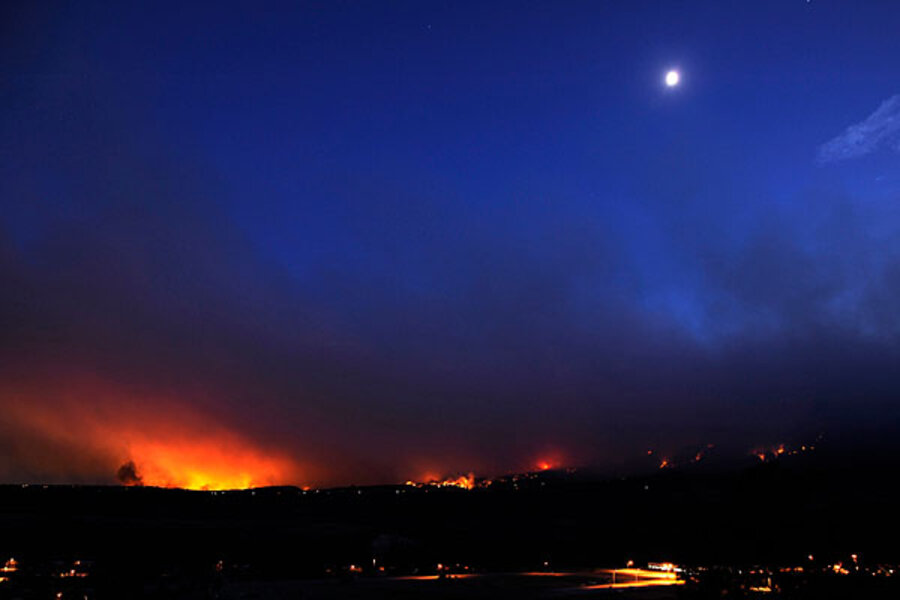In fleeing Colorado Springs fire, tales of kind neighbors and potty breaks
Loading...
| Colorado Springs, Colo.
In some ways, I have become a statistic.
The fire that started in the popular hiking destination of Waldo Canyon west of town has consumed more than 19,000 acres and 346 houses. It has taken the efforts of 1,008 firefighters to reach only 10 percent containment. Now, tragically, it has claimed a life, as well as led to some 32,000 people being evacuated.
I am one of them, and I can tell you what it is like.
Those iconic scenes of bumper-to-bumper traffic, with people fleeing the neighborhoods west of Colorado Springs for friends’ homes or hotel rooms all the way north to Denver are ones I saw from the driver’s seat of my own Subaru Legacy.
The searing image of hot winds whipping across the city, bending trees and sending black smoke boiling across the sky – the sight of an orange glow burned across the bottom of dense, oily clouds – is something I watched from my front porch.
I can tell you the hour-long flight from my house after the evacuation notice came was strangely courteous. One man held a pink homemade sign with “Please be patient” scribbled on it in purple marker. Another sign on a house welcomed evacuees to take bottled water and visit the restroom as they waited in line.
All this amid a seeming war zone, with police directing us past barricaded streets and with helicopters dumping water and slurry on the flames and ambulances screaming through the streets.
I can also tell you what it smelled like – the air reeking of wood smoke layered with burned rubber.
But I cannot say how someone prepares for such a moment.
We had been watching the news nonstop for days as the fire raged toward the city line. The smoke plume first appeared Saturday. By Tuesday afternoon, the wind gusts hit 65 m.p.h., and the neighborhoods due west of us were told to prepare to leave.
By 4 p.m., as the neighbors and I watched smoke billowing from the mountains, orange flames suddenly exploded through the smoke and raced across the top of the ridgeline. It wasn’t a fire anymore; it was an inferno that had tripled in size to something that Colorado Springs Fire Chief Rich Brown called “a firestorm of epic proportions.”
And it was here.
Emergency responders raced toward the flames, cornering on two wheels, sirens screaming. The call came not long after: We had to leave.
Our house filled with smoke as I struggled to pack. What does one pack when everything is at stake? I saw one woman in our neighborhood loading 20 racing bicycles onto a trailer.
Emergency newscasts recommended the “Four P’s” – photographs, paperwork, pets, and prescriptions. I cornered the dog and cat and grabbed the boxes containing our important papers – house deed, car titles, passports, birth certificates, Social Security cards. I threw clothes into a suitcase, unplugged the computer, and grabbed photo albums and wedding mementos.
What else?
My newspaper clippings that I had never turned into PDFs. My husband’s baby book his mom had made for him. My wedding dress, hanging in the closet since its use in 2008.
Everything else was “replaceable.”
When my husband, Brian, finally arrived home at 6:30 p.m., barely squeezing through the road blocks, we loaded our two cars and backed out of the house, wondering if that was the last time we’d ever see it.
Once we were safely on the east side, we looked back on the scene through burning eyes – a blackened sky, with red flames leaping across the darkened silhouette of the ridge.
We are now staying with our landlord and his family, who were gracious enough to take us in. We heard Thursday that our house is standing, though we anticipate smoke damage to the interior and exterior. For his part, Gov. John Hickenlooper has requested a federal disaster declaration in response to the wildfires burning across the state.
Meanwhile, my husband and I are still trying to live as normal a life as possible – still going to work, still watching the news, still hoping to hear when we might be able to go home.
Still waiting.







